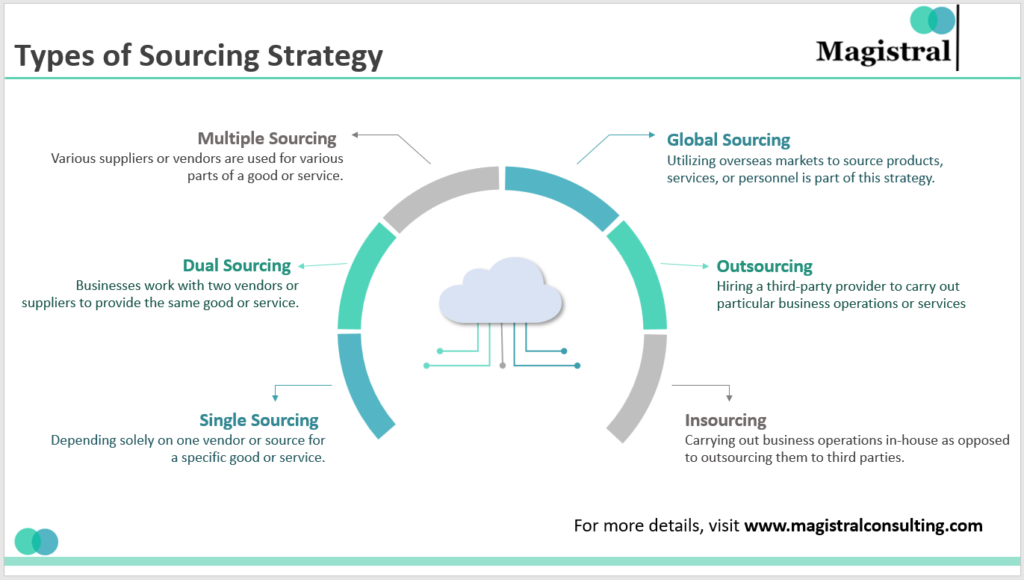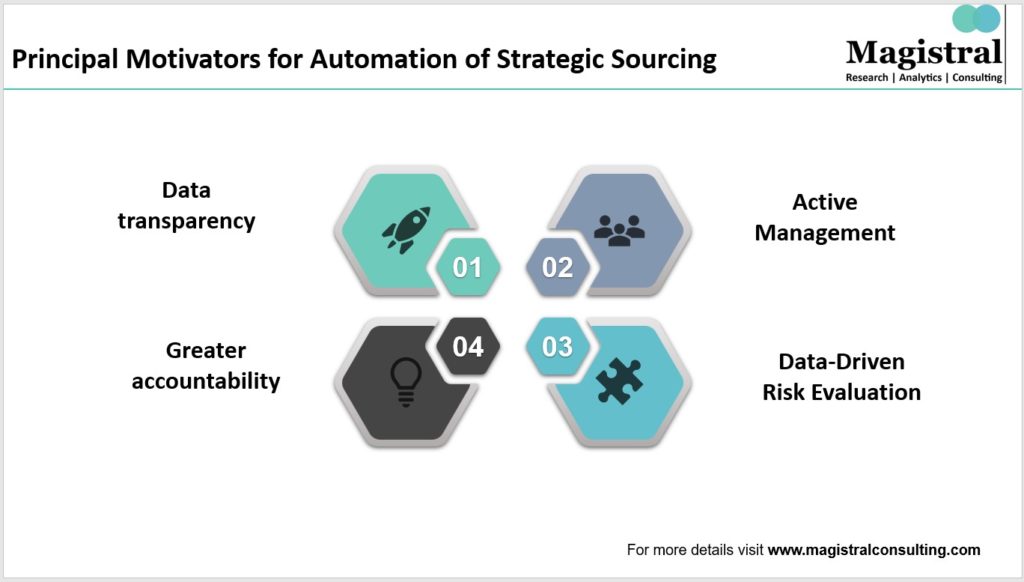Introduction
A sourcing strategy is a strategy that a company uses to find products, services, or personnel from outside sources. It describes how the company will find, assess, choose, and manage suppliers or vendors to effectively and efficiently meet its demands. The evaluation of the organization’s unique requirements forms the basis of the sourcing strategy. This entails being aware of the kind of products, services, or talent that are required as well as their volume or frequency. The firm can lay the groundwork for the sourcing process by outlining the criteria precisely.
The next step after identifying the requirements is to locate suitable vendors or suppliers who can meet them. To locate acceptable providers, market research is carried out. During the supplier identification process, variables like skills, knowledge, dependability, financial stability, and track record are taken into account. The business identifies possible suppliers, assesses them, and chooses the best ones. Suppliers are assessed using criteria that take into account aspects including pricing, quality, delivery time, customer service, and alignment with the organization’s beliefs and objectives. The company reduces the list of providers through this assessment and selects those that best suit its requirements.
The sourcing strategy takes ethical issues into account as well. When choosing suppliers, businesses are urged to take ethics and sustainability into account. This may entail examining a supplier’s adherence to labor practices, legal and regulatory requirements, and environmental, social, and governance (ESG) standards. A sourcing strategy should, in general, be in line with the objectives, financial constraints, and operational needs of the company. It should be adaptable enough to change with the times and meet changing company requirements. Organizations may maximize their external sourcing efforts and accomplish their goals by having a well-defined and effective sourcing strategy. A constant component of the sourcing strategy is continuous improvement. The company routinely examines and assesses the sourcing procedure to find opportunities for enhancement. To find potential improvements or optimizations, feedback from internal stakeholders and suppliers is solicited. It’s critical to keep abreast of technology and market trends to adjust the sourcing strategy to changing conditions.
Types of Sourcing Strategy
Depending on their particular needs, objectives, and industry, businesses can use a variety of sourcing tactics. It’s crucial to remember that sourcing tactics can be blended or altered depending on the particular conditions of a firm. The decision on which sourcing method to use is influenced by several variables, including budgetary constraints, risk tolerance, market dynamics, desired level of control, and strategic priorities. Here are a few typical sourcing techniques:

Types Of Sourcing Strategy
Single Sourcing Strategy
This tactic requires depending solely on one vendor or source for a specific good or service. Benefits include easier relationship management, the possibility of cost savings from purchasing in bulk, and closer cooperation with the supplier. If the sole source has problems or falls short of expectations, there is also a chance of supply disruptions.
Dual Sourcing Strategy
In this technique, businesses work with two vendors or suppliers to provide the same good or service. With a competitive bidding procedure, better terms can be negotiated as well as increased supplier competition and a backup supply in case of disruptions. Greater supply chain resilience and risk reduction are provided by dual sourcing.
Multiple Sourcing Strategy
With this tactic, various suppliers or vendors are used for various parts of a good or service. Lowering reliance on a single source, offers flexibility, diversification, and risk mitigation. Businesses can take advantage of supplier competition, bargain for good terms, and keep a diverse portfolio of suppliers.
Global Sourcing
Utilizing overseas markets to source products, services, or personnel is part of this strategy. Global supply chains are used by businesses to gain access to low-cost resources, specialist knowledge, and new markets. Global sourcing can have benefits including cheaper production costs, access to specialized talents or technologies, and chances to grow the market.
Outsourcing
The act of hiring a third-party provider to carry out particular business operations or services is known as outsourcing. It may entail outsourcing non-core tasks like IT support, customer service, production, or back-office tasks. Organizations can increase operational efficiency, access specialized expertise, focus on their core competencies, and lower expenses by outsourcing.
Insourcing
Insourcing, also referred to as in-house sourcing, refers to carrying out business operations in-house as opposed to outsourcing them to third parties. To have more control over quality, intellectual property, data security, and confidentiality, organizations may choose to insource. It enables firms to maintain closer team communication, internalize expertise, and preserve strategic competencies.
Advantages of a Well-Planned Sourcing Strategy
In addition to cost reductions, improved supplier selection, improved supplier relationships, risk mitigation, time savings, increased focus on core competencies, flexibility, and ethical sourcing, a well-designed sourcing strategy also offers many other benefits. Organizations may streamline their procurement processes, add value, and accomplish their strategic goals by putting an efficient sourcing strategy in place. Here are several major advantages:

Advantages of Well-Planned Sourcing Strategy
Reduced Expenses
Organizations can locate suppliers who can offer products, services, or talent at reasonable pricing by using an efficient sourcing approach. Organizations can reduce their procurement costs by negotiating favorable terms and making use of economies of scale.
Improved Vendor Relationships
Setting up clear channels of communication, performance measurements, and expectations with suppliers is part of a sourcing strategy. As a result, relationships and collaboration are strengthened, which boosts supplier responsiveness, customer satisfaction, and reliability. Long-term relationships with suppliers can lead to special treatment, first access to resources, and a fruitful interchange of information and concepts.
Minimized Risk
An organized sourcing strategy includes risk analysis and backup plans. It enables businesses to expand their pool of suppliers, lowering reliance on a single source and lowering the risk of supply chain interruptions. Active risk management guards against quality problems or other unforeseen difficulties while ensuring operational continuity and minimizing potential disruptions.
Time Management and Productivity
By defining defined policies, procedures, and best practices, a sourcing strategy simplifies the procurement process. As a result, supplier sourcing, appraisal, and selection take less time. Organizations may speed up the procurement process, make informed decisions, and improve overall operational efficiency by adopting a systematic strategy.
More Emphasis on Core Competencies
Organizations can concentrate on their core capabilities by outsourcing non-core functions or acquiring specialized knowledge through sourcing techniques. Organizations can access specialized expertise, technology, or resources by utilizing external skills, allowing them to concentrate on their distinct value offering and strategic goals.
Responsible and Ethical Sourcing
Organizations can support socially responsible practices, environmental stewardship, and fair labor conditions by integrating ethical and sustainability considerations into their procurement strategies. Organizations can support their efforts in corporate social responsibility, improve the reputation of their brand, and satisfy the demands of socially conscious clients by choosing suppliers that share similar principles.
Magistral’s Services on Sourcing Strategy
Magistral has extensive experience in research and analytics, which can aid in cost reduction through sourcing strategy. Some of the services are as follows:
-Spend analytics: – Review expenditure profiles from the past and the future to find potential for supplier consolidation and tail spend optimization.
-Cost and price analytics: – Guides informed judgments and creates scenario-based, predictive cost models and pricing estimates.
-Supplier analytics: – Develop supplier sustainability scorecards, track supplier performance against Service level agreements, and create scenario models for bids and tenders.
-Risk analytics: – Pay early alerts for category risks and supplier-related risk signals. With unique analytics that blends internal and external data sources to unearth hidden insights, you may advance your goal of digital procurement transformation.
-Real-time recommendation: – Be a strategic partner to the company by recommending fresh, successful approaches to risk management, innovation, and cost reduction.
About Magistral Consulting
Magistral Consulting has helped multiple companies to reduce operations costs through its offerings in Procurement and Supply Chain.
For setting up an appointment with a Magistral representative visit www.magistralconsulting.com/contact
About the Author
The article is authored by the Marketing Department of Magistral Consulting. For any business inquiries, you can reach out to prabhash.choudhary@magistralconsulting.com

